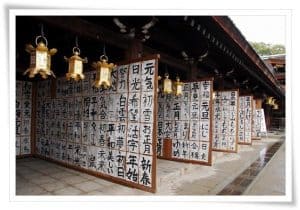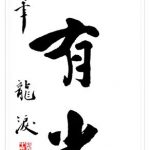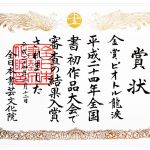Text: Ponte Ryūrui (品天龍涙)
English editing: Rona Conti
Japanese/Chinese editing: Yuki Anada

In Japan, on the second day of the first month of the calendar, there is a tradition of writing the first calligraphy of the New Year. This custom originated in the Imperial Court long before it became a nation-wide custom. According to the kyūreki (旧暦, きゅうれき), the last Japanese lunisolar calendar that was in use between the years 1844 and 1872, an official event celebrating the first day of work in the Imperial Court was held every 2nd of January. This event was further popularised by the famous Terakoya (寺子屋, てらこや), originally “temple schools” (i.e. educational facilities located in Buddhist temples) which became private educational institutions which taught reading and writing to children of Japanese commoners during the Edo period (江戸時代, えどじだい, 1603-1868).
Formerly, the writings were performed in front of an image of the so called “God of Scholarship”, Sugawara no Michizane (菅原 道真, すがわらのみちざね, 845 – 903 C.E.), an exceptional scholar, poet, and a highly ranked politician active during the Heian Period (平安時代, へいあんじだい, 794 – 1185 C.E.). Today, one can observe similar events taking place in Tenmangu shrines (天満宮, てんまんぐう, Tenmangū, i.e. “Shinto shrines dedicated to the spirit of Sugawara no Michizane”) which can be found all over Japan.

Perhaps you are curious as to the origin of Sugawara no Michizane’s honourable title. In brief, he was a brilliant scholar and politician. Due to his bilingual skills (Japanese and Chinese) and a very good relationship with Emperor Uda (宇多天皇, うだ てんのう, Uda Tennō, 867 – 931 C.E.), he climbed the political and scholastic ladders quite rapidly. When Emperor Uda died, Michizane was at the peak of his political career, having achieved his most prominent titles. He then became involved in a political conflict with one of his rivals and was demoted to being a second rank official. A few years after his death, a series of disasters hit the Imperial Court, among them the very building of the Imperial Palace was struck numerous times by lightning. All of those natural disasters were thought to be due to the restless spirit of Sugawara no Michizane, and thus, the authorities decided to build a shrine dedicated to appeasing his spirit.

Today, this yearly event is known as kakizome (書き初め, かきぞめ), which literally means “first writing of the year”. The text itself was traditionally a poem praising the arrival of spring, the blooming life or longevity itself. Currently, one can freely write whatever one wishes, then either burn the text during the Sagichō (左義長, さぎちょう), or keep it for oneself. Sagichō is a very popular custom involving the burning of decorations from the New Year, Daruma (達磨, だるま), and kakizome, though its naming differs depending on the region. It is said that if the calligraphy ashes from the kakizome are lifted high by the breeze, the calligraphers skill in writing will improve greatly in the coming year.
Kakizome became part of the national curriculum in Japanese schools, though I fear that it is not very well liked by the students to whom it is assigned by their teachers as homework. Nonetheless, every year, tens of thousands of people from elementary school students to Japanese citizens to practitioners and masters of calligraphy participate in the first writing of the year.
Kakizome organised by the All Japan Literature and Calligraphy Association (全日本書芸文化院, ぜんにほんしょげいぶんかいん, Zen Nihon Shogei Bunkain) is one of the biggest events of this kind in Japan. I participate every year, though only once did I join a massive group of calligraphers performing kakizome in Tokyo. This year I submitted a hansetsu (半切, はんせつ, lit. “half cut”) size work, which is approximately 135x35cm, with a Chinese phrase that reads: 文物有光輝 (pinyin: wén wù yǒu guāng huī), which means “Cultural relics are magnificent.” (Figure 3). To my great delight,,my work won a Gold Award on the national level (Figure 4), both surprising and pleasurable.

I was actually considering burning my kakizome to follow tradition, but, upon reflection, I decided against this idea. I realised how difficult it would be to explain to the Police that the foreigner they were going to take into custody was not in fact a pyromaniac trying to commit arson by setting fire to a local Ward Office, but rather someone who was promoting the forgotten art of calligraphy.
